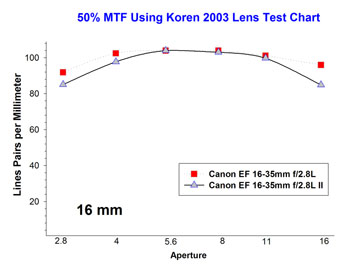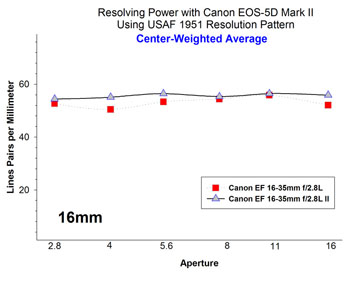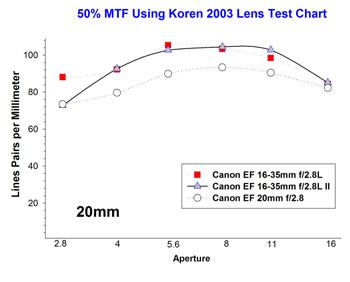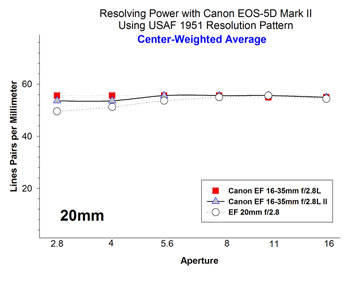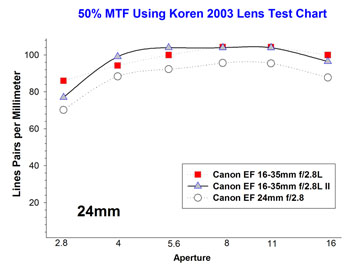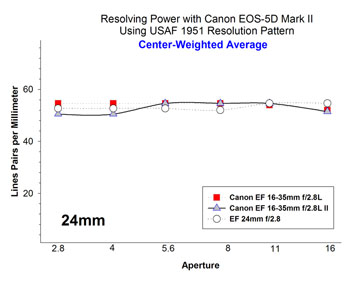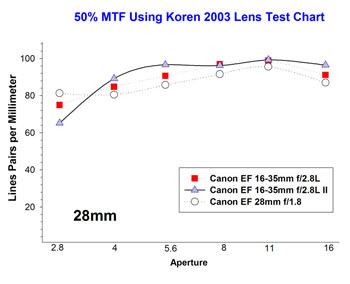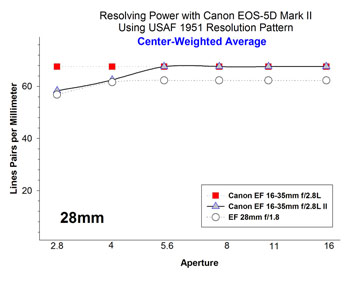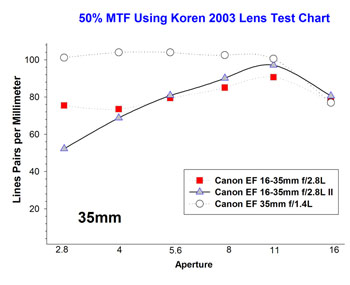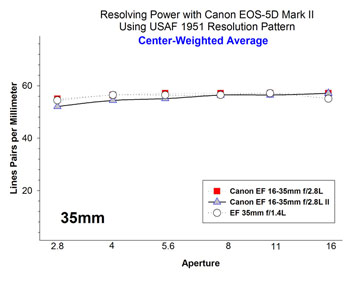Review of Canon EF 16-35mm
f/2.8L II
Comparison with EF
16-35mm f/2.8L
In this review, performance of the Canon EF 16-35mm
f/2.8L II is compared to that of the first version of the lens (EF
16-35mm f/2.8L).
Statements from the Canon website about the EF
16-35mm f/2.8L II:
It has been
specifically designed for improved edge-to-edge image quality.....It
features 3 high-precision aspherical lens elements, each of a different
type: ground, replica and GMo for even better image quality than the
original EF 16-35mm f/2.8L USM. The circular aperture produces a
beautiful and natural background blur when shooting at wider apertures.
Other features include internal focusing, a ring type USM (Ultra Sonic
Monitor), and new AF algorithms for fast and quiet autofocusing.
A brief performance review of the original EF 16-35mm f/2.8L
lens relative to the EF 17-40mm f/4L lens is
HERE.
Lens
Specifications
|
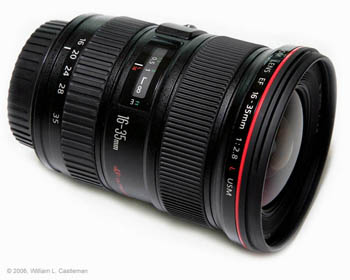 |
50% MTF and Resolution
Data
determined using these
methods.
Performance of both lenses is excellent and
noticeably better than the three non-L primes tested. The first version of
the lens gave slightly better 50% MTF performance at f/2.8 than the second
version.
Corner Sharpness and Lateral
Chromatic Aberration
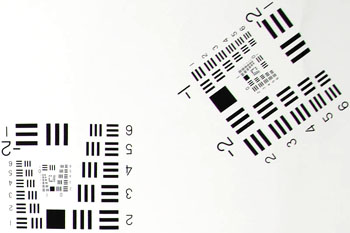 |
16mm
20mm
24mm
28mm
35mm
|
As a general remark, corner line resolution at f/2.8
and f/4 is slightly better in the first version of the lens. However,
there is noticeably less lateral chromatic aberration in the corners at
f/2.8 and f/4 with the second version of the lens than the first
version, especially at 16mm and 20mm. The differences between the two
lenses are small and are generally not visible in most photographs.
Do
I have a bad version II lens sample?
No,
see tests HERE |
|
Linear Distortion at f/8
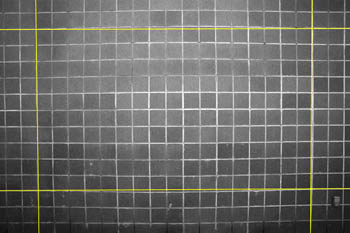 |
16mm,
20mm, 24mm, 35mm
|
Linear distortion with both lenses is remarkably well
controlled. Both 16-35mm lenses have very mild barrel distortion at 16mm
and mild pincushion distortion at 35mm. The second version of the lens
has slightly more pincushion distortion at 35mm than the first version.
The second version also has slight pincushion distortion at 24mm.
At
16mm, the first version of the lens has a slightly wider field of view
than the second version. The wider "16mm" lens setting field
of view is noticeable at infinity focus in landscape application. |
Vingetting from f/2.8 to f/8
Lenses were tested at infinity focus using a led illuminated light box
with double opaque white diffusion screens.
 |
16mm
20mm
24mm
28mm
35mm |
The second version of the lens has slightly
more light drop off at f/2.8 at the 16mm and 20mm settings than the
first version of the lens. |
Out of Focus Background Detail
(Bokeh) and Highlights
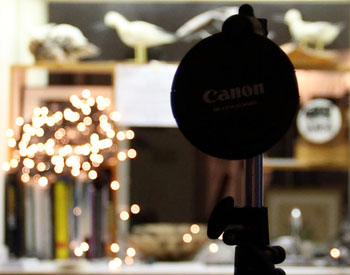 |
24mm
|
At f/2.8, f/4 (and to a lesser extent f/5.6), out of
focus background (bokeh) is much more smooth and highlights and
reflections of lights in the background are more even and smooth with
the second version of the lens.
Focus point is lens cap in the
foreground. Background is about 20 feet behind the lens cap. The image
has been cropped to a small portion of the total field. |
Flare and Internal Reflections
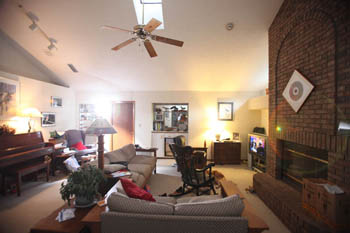 |
16mm
20mm
|
Both lenses are very resistant to flare. Internal
reflections are better controlled in these test images with the second
version of the lens. |
Building Photograph Assessing
Chromatic Aberration and Image Sharpness
 |
16mm,
24mm, 35mm
Both lenses produce high quality images at
f/11/. At the 16mm setting, the first version of the lens produces mild,
but noticeable, chromatic aberration in the upper right corner of the
field that is not present in the image made with the second version of
the lens. |
Other Building Photographs
 |
Both lenses give outstanding quality images at f/8 to f/13. It is
difficult to find any difference in the excellent image quality that
both lenses give from 16mm to 30mm. |
Conclusions
Both the
EF 16-35mm f/2.8L and the EF 16-35mm f/2.8L II USM lenses produce superb
images with minimal distortion across a wide range of angles and
apertures. Both lenses have excellent central field imaging performance
when shot at f/2.8. It is difficult to see a difference in the high
quality images produced by either lens.
Comparison
Summary of 1st and 2nd Versions of the Lens
| EF 16-35mm f/2.8L II USM (2nd version) |
EF 16-35mm f/2.8L USM (1st version) |
Strengths
- Lateral chromatic aberration in far corners of the field is
corrected better than in the first version of the lens
- Internal relections from bright light sources are better
controlled than in the first version
- Out of focus backgrounds and highlights are smoother and more
even (better bokeh) at f/2.8 and f/4 than with the first version of
the lens
|
Strengths
- Slightly less linear distorsion at 24mm and 35mm settings than
with the second version of the lens
- Slightly wider field of view at 16mm than with the second version
of the lens
- Sharp corner performances in center and edge of field
- Uses 77mm diameter filters (more compatible with filter set you
use with other L-zooms)
- Slightly smaller and lighter than second version
- Less expensive on used market than second version of the lens
|
Potential Weaknesses for Some Users
- Slightly more linear distortion at 24mm and 35mm settings than
with the first version of lens
- Slightly narrower field of view at 16mm setting than with the
first version of the lens
- Requires 82mm diameter filters
- Slightly larger and heavier than first version of the lens
|
Potential Weaknesses for Some Users
- More lateral chromatic aberration in corners at 16 and 20mm
setting than with the second version of the lens
- More internal reflections from bright light sources than with
second version of the lens
|
Equipment
Review Index
Home
©
2006-2009, William L. Castleman
First
version posted 18 June, 2006. Second version posted 22 July 2009 and
revised 05 August 2009

